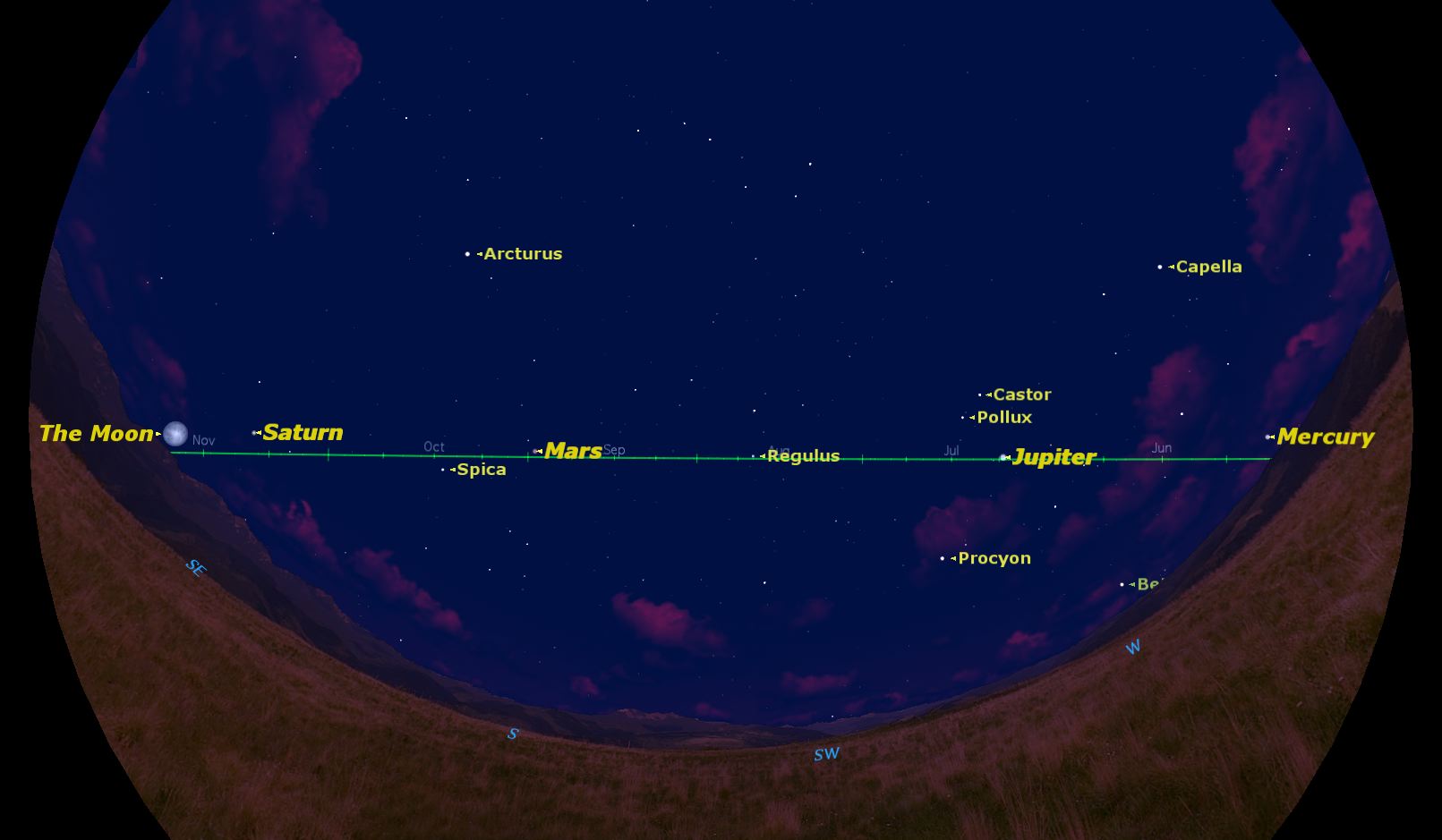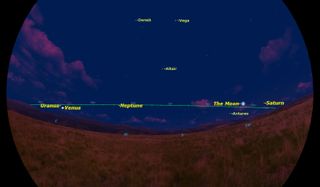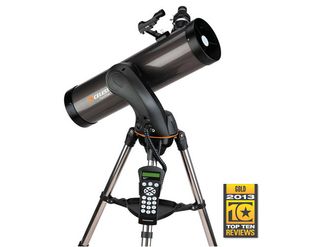Mars, Jupiter, Saturn and More: Don't Miss the Planet Parade in Tonight's Sky

If you go out tonight (May 14) about half an hour after sunset and have clear weather, you will see a number of bright objects in the sky. The brightest of these celestial lights are four of five planets visible to the naked eye this month, with the full moon completing the view — a sight you won't want to miss.
To begin our planet parade in May's night sky, let's look low in the northwest. There you can find the tiny speck of Mercury, never far from the sun. You may need a binocular to spot it.
A bit higher in the west is Jupiter, long past its opposition on Jan. 5, and now sinking rapidly behind the sun. If you have a telescope take a look to see Jupiter's four bright moons.
Due south is Mars, now well past opposition on April 8, and fading fast in brightness. If you have a powerful telescope, you might still spot the Red Planet's tiny northern polar ice cap. [Amazing Night Sky Photos for May (Gallery)]
May full moon and more
Rising in the southeast, just ahead of the full moon, is the planet Saturn, just four days past opposition.
The rising moon and Saturn mark the midpoint of the night: they will be high in the southern sky at local midnight (1 a.m. local time in most areas because of Daylight Saving Time).
Get the Space.com Newsletter
Breaking space news, the latest updates on rocket launches, skywatching events and more!
If you go out about an hour before sunrise tomorrow morning (May 15), the moon and Saturn will have moved to the southwest, where they are setting. Notice how much the moon has moved relative to Saturn during the night.

Venus will have risen low in the southeast, still very bright, although it soon will be lost in the sun's glare.
In the southeastern sky you will need binoculars to spot Neptune, the farthest planet from the sun.
Finally, Uranus, also requiring binoculars, will be close to Venus for the next few nights.
A planet parade in the night sky
Notice how all seven planets and the moon fall close to the green line which marks the ecliptic — the path the sun follows across the sky. In the sky maps in this guide, I've adjusted the view to emphasize that it is a straight line, but this is not always obvious when you see it spread across the sky. Having it marked by so many bright planets helps to visualize it.
Because all the planets and the moon follow courses close to the ecliptic, they frequently have close encounters, called conjunctions, as they pass one another. Sometimes one planet may even pass in front of another as seen from Earth, resulting in eclipses, transits, and occultations.

In April, stargazers on Earth saw two eclipses: a lunar eclipse on April 15, when the Earth cast its shadow on the moon; and an annular solar eclipse on April 29, when the moon passed in front of the sun.
This month, we will have a conjunction of Uranus and Venus on May 15 and an occultation of Saturn tonight. However, the Saturn occultation will occur while the planet and the moon were below the horizon in North America, so stargazers there will miss it. Observers in Australia, however, are well placed to see the event.
Tonight, and for the next few weeks, all seven planets are visible, making it a great opportunity for a "Solar System Marathon." How many Solar System bodies can you see in a single night?
You can also seek out an asteroid or two, a telescope view of two comets, the zodiacal light, and a meteor or two. If you are really lucky, there will be a bright display of aurora, though these have been few and far between during the current subdued solar maximum. Be sure to count the moons you see circling Jupiter and Saturn!
Editor's Note: If you take an amazing photo of the planets, or any other night sky view, that you'd like to share for a possible story or image gallery, please contact managing editor Tariq Malik at spacephotos@space.com.
This article was provided to Space.com by Simulation Curriculum, the leader in space science curriculum solutions and the makers of Starry Night and SkySafari. Follow Starry Night on Twitter @StarryNightEdu. Follow us @Spacedotcom, Facebook and Google+. Original article on Space.com.
Join our Space Forums to keep talking space on the latest missions, night sky and more! And if you have a news tip, correction or comment, let us know at: community@space.com.

Geoff Gaherty was Space.com's Night Sky columnist and in partnership with Starry Night software and a dedicated amateur astronomer who sought to share the wonders of the night sky with the world. Based in Canada, Geoff studied mathematics and physics at McGill University and earned a Ph.D. in anthropology from the University of Toronto, all while pursuing a passion for the night sky and serving as an astronomy communicator. He credited a partial solar eclipse observed in 1946 (at age 5) and his 1957 sighting of the Comet Arend-Roland as a teenager for sparking his interest in amateur astronomy. In 2008, Geoff won the Chant Medal from the Royal Astronomical Society of Canada, an award given to a Canadian amateur astronomer in recognition of their lifetime achievements. Sadly, Geoff passed away July 7, 2016 due to complications from a kidney transplant, but his legacy continues at Starry Night.












